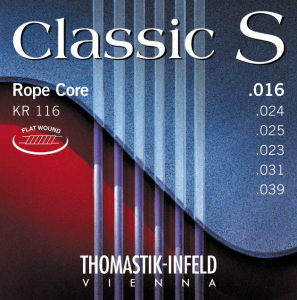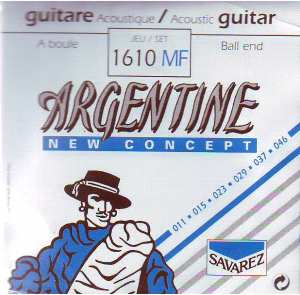
Holy crap! Now THAT’S a guitar string!
Man, it pays to curate a blog frequented by smart people!
I wrote last week about my experiment with silk-and-steel strings.
It’s the latest chapter in my ongoing search for the right acoustic strings. Most available options simply sound far too harsh and bright to my ears, especially for fingerstyle playing on the small-bodied guitars I favor. Even though the Martin silk-and-steels I used were dramatically quieter than most bronze strings, I dug their warmth and strong fundamentals — and the absence of the hyped sizzle of bronze.
Several of you responded in comments with string suggestions, including several types I barely knew existed. Despite some rather shocking expenditures for these high-end, imported strings, I found much to love. Now I’m rich in tone, if nothing else.
Since I’m hot on the trail of a cool new fuzz circuit, I haven’t yet had time to record demos (and besides, I’d rather wait till the strings wear in a bit). But I’d like to share details about several products that impressed me.
Reader Rebeat suggested John Pearse Phosphor Bronze and Silk, which I put on my 000-sized Lowden, an extremely bright instrument. The wound strings of this set (which is available only in gauge .011/.049) features a silk layer between the core are bronze wrap. The result truly seems to split the difference between bronze and silk-and-steel strings. They feel a bit like conventional bronze, but with markedly less string noise and hyped treble. They’re quieter too, though not as quiet as silk-and-steels. It’s exactly the adjustment I wanted for this guitar, and I’m delighted with the results. (Also, these strings seem far likelier to withstand aggressive pick-style playing than any regular silk-and-steel set.)

I hope that white thing is part of his poncho.
Reader smgear directed me to Savarez Argentines. As much as I love Django, I’ve never had much interest in trying to sound like him, so I’ve never tried a strings of this type. In fact, I had no idea how many manufacturers produce “Gypsy jazz” strings. (I also bought a set of seemingly identical John Pearse Nuage strings.) Both are quieter than bronze strings, with a soft, supple feel. There’s not a lot of mass to the sound — it’s more about a cutting tone to make single-note solos stand out in an acoustic band. Since the tone is a bit plinky, I put them on my two plinkiest-sounding guitars: the oddball Cathedranola heard here, and my plastic Maccaferri (a cheapo ’50s guitar conceived by the guy who created Django’s signature Selmers).
I owe extra thanks to renowned luthier/guitar tech Al Milburn, who directed me to Thomastik-Infeld Classic S rope-core strings. (I haven’t yet tried the non-rope-core version.) Holy crap — I’ve never encountered anything like these strings! The gauges are weird: .016 through .039! And all six are wound — the trebles feature nylon tape wound on a rope core, and the basses are flatwound, silver-plated copper on a rope core.
Sounds bizarre — but they don’t sound bizarre, if you follow. As you’d expect, they’re quieter than bronze, with a warmer, softer timbre. Yet there’s far more treble animation than you might suppose — you’d never call them “dark” or “dead-sounding.” You don’t get the nasty, scraping top-end of bronze, yet they have a lovely open/airy quality, paired with strong, clear fundamentals. And while the gauges are unconventional, the feel isn’t. If you weren’t paying attention, you’d think you were playing an .011-.046 set. Granted, they’re over $30 a set — but I’ve already discovered that the Thomastik flatwounds I’ve been using on many of my electrics last far longer than conventional roundwounds. We’ll see if that’s true for the Classic S set as well.
I am completely infatuated with the way these strings feel and sound — though I’d like to spend a few more days playing and recording with them before deciding whether it’s the love of a lifetime, or just a diverting summer crush.








Joe, this is great info. It’s territory that nobody seems to want to tread. I’m always too cowardly to stray from my main set of strings, replacing them over and over with the same thing, but this at least points me in directions where I should definitely explore. Grazie!
Prego, amico mio! When it comes to procrastination, auditioning new types of strings is right up there with straightening your desk! 😉
Seriously, though — my mind has been blown many times since starting this blog by great suggestions from readers. Flatwounds on 12-strings and baritone guitars…pseudo-gut nylon strings…rubber bass strings…”rope core” strings…the list goes on. It’s fascinating stuff (and that’s without even getting into the willful obfuscation practiced by certain string companies we could name).
Okay, so what about the new fuzz circuit?
Well, I’ve looking once again at this great chart:
https://aronnelson.com/gallery/main.php/v/TCobrettis-Stuff/TB_60s_fuzz_comparison_chart.jpg
…which groups together a bunch of the “brand x” two-transistor fuzzes of the ’60s. I’ve always loved the IDEA of these offbeat fuzzes that don’t quite sound like Tonebenders or Fuzz Faces, but I usually find them disappointing in the flesh. I’ve been doing some experimenting, like schematics that “split the difference” between these and a classic fuzz face, mixing vintage and modern components, and playing with things that are sort of “Fuzz Face/Fuzzrite hybrids.”
I though I had something awesome yesterday, but it wound up sounding less cool in the studio that an the workbench. But I’m still fishing….
Just recorded an album for a friend this week and was fortunate enough to have another friend’s baritone (Eastwood, Mosrite style) and put it to good use. When I first picked it up I thought “needs heavier strings, preferably flat-wounds”.
Tonefiend: Poisoning the minds of guitarists worldwide.©
Well, the flatwounds idea probably came from here, but the amount of buzzy string clatter was really had me thinking about it. I try cables out on everything then usually settle for something in between. The same friend who’s lending me the bari went out and bought me a Dano the other day (I know, whatta’ guy!!), so I’ll keep you posted on both the axe and the strings it (I) likes.
Ive been a fan of Arjaunez Gold on My Yamaha classical over the years..if not those id settle for Augustine..as far as regular acoustic like dreadnaught or other types..been a fan of Martin Bronze…I guess I like deep woody chimey tones on the lows…and a buttery tone on the lows with balanced mids and enough sparkle to carry the tone if that makes any damn sense.
I meant on the highs on the latter half…My typoes forever haunt Me..LOL
The typo could have been worse: “A buttery tone on the thighs.”
those rope cores sound intriguing. The argentines should get a little less plunky after a couple hours of playing (but should be a great fit for the mac). How did I miss your cathendrola! That’s awesome!
The rope cores are FREAKY! I still like them. I’ve had some player friends come over and try them, and at the very least, folks find them fascinating. I haven’t had time to break in the Argentines, but I have a sense that they’re good fits for those two guitars.
Any opinion on how the John Pearse’s differ from Thomastik branded silk and bronze (Plectrum?) strings? Going to try one of these to sets when I change out the silk and steels I have on my parlor…
I love the Pearse set, but haven’t tried that particular Thomastik set. But I believe there’s some connection between the two companies, and that some Pearse strings are actually Thomastiks. Can anyone clarify?
I’m pretty sure the Pearse strings aremad by Thomastik – hence the question, they look like they could be the same strings in different boxes.
Couldn’t find the Pearse strings locally so restrung the parlour with Thomastik Plectrum’s today – they’re ok, will wait to hear how they settle in but not a magic fit for the guitar / my playing. They are sorta midway between the Martin silk and steel I had on there and ‘normal’ strings, perhaps more towards a standard set. Too bright / bitey for my taste. They do sound like they’d work better with a pick than the silk and steel set.
I wonder how they compare to the Pearse silk-and-bronze…
I’m going to get a set of the Pearse strings for next time – I’m quite interested to see how they compare too.
So, long time gone but…
Ended up with the Thomastik Plectrum’s on the guitar for a good four months. Once they settled in / I got used to them they actually worked really well. The treble bite mellowed and they had lots of give in them (sorta like a set of nylons) that worked really well for me. I recently switched to a double-drop-d tuning (because… Buddy Miller) and the sound of the Thomastik’s paired great with this tuning and country / folk stuff. They did ‘bottom out’ on my guitar but this is probably due to the smaller body.
I replaced the Thomastik’s with Pearse strings last week as the Thomastik’s finally gave up the ghost.
I don’t like them.
(Not yet, anyway).
They are too ‘taught’ and aren’t as loud as the Thomastik’s. They are a bit less forward in the low-midrange and that’s not really working for me. The tone difference is really quite dramatic and makes the guitar sound small. They do feel a bit more like electric flats than acoustic silk and steel – they don’t have the ‘springiness’ I like with the martin strings. I’ll gig them a bit and my opinion may change as they wear in (I like old strings).
So, maybe give the Thomastik’s a whirl?
Hey Joe, I’m curious what strings you settled on for the parlor guitars. Did you stick with rope cores, the JP silks, etc or have you continued experimenting?